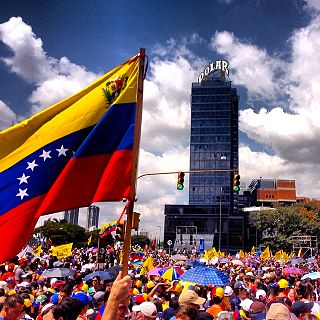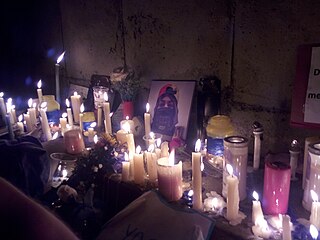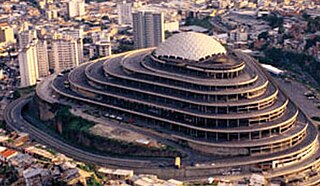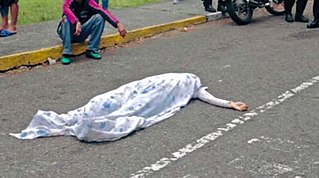
The Bolivarian National Intelligence Service is the premier intelligence agency in Venezuela. SEBIN is an internal security force subordinate to the Vice President of Venezuela since 2012 and is dependent on Vice President Delcy Rodríguez. SEBIN has been described as the political police force of the Bolivarian government.

The Simón Bolívar Symphony Orchestra of Venezuela is a Venezuelan orchestra. Named after the Venezuelan national hero Simón Bolívar, it was initially the apex of the nation's system of youth orchestras. By 2011, it was no longer officially a youth orchestra as many of its members remained with the orchestra and the average age had risen to the early 20s. It was replaced as the national youth orchestra by the Teresa Carreño Youth Orchestra.

Génesis Cristina Carmona Tovar was a Venezuelan fashion model, beauty queen, and college student who was killed while protesting against the government of Venezuela during the 2014 Venezuelan protests. She later became a symbol of protest against the Nicolás Maduro government during the time of demonstrations in the country.

The 2014 Venezuelan protests began in February 2014 when hundreds of thousands of Venezuelans protested due to high levels of criminal violence, inflation, and chronic scarcity of basic goods because of policies created the Venezuelan government. The protests have lasted for several months and events are listed below according to the month they had happened.

In 2014, a series of protests, political demonstrations, and civil insurrection began in Venezuela due to the country's high levels of urban violence, inflation, and chronic shortages of basic goods attributed to economic policies such as strict price controls. Mass protesting began in earnest in February following the attempted rape of a student on a university campus in San Cristóbal. Subsequent arrests and killings of student protesters spurred their expansion to neighboring cities and the involvement of opposition leaders. The year's early months were characterized by large demonstrations and violent clashes between protesters and government forces that resulted in nearly 4,000 arrests and 43 deaths, including both supporters and opponents of the government.

Bassil Da Costa[a] was a Venezuelan university student, killed during the 2014 protests against the Venezuelan government, the first death of the wave of protests. Da Costa was a marketing student at the Universidad Alejandro de Humboldt in Caracas.

The 2017 Venezuelan protests began in late January following the abandonment of Vatican-backed dialogue between the Bolivarian government and the opposition. The series of protests originally began in February 2014 when hundreds of thousands of Venezuelans protested due to high levels of criminal violence, inflation, and chronic scarcity of basic goods because of policies created by the Venezuelan government though the size of protests had decreased since 2014. Following the 2017 Venezuelan constitutional crisis, protests began to increase greatly throughout Venezuela.

Neomar Alejandro Lander Armas was a Venezuelan barman and protester killed during the 2017 Venezuelan protests.

Tamara Sujú Roa is a Venezuelan criminal lawyer and human rights specialist.

Torture in Venezuela has been a consistent phenomenon throughout its history. Various dictatorships from the Spanish colonial era into the twentieth century utilized torture against common criminals and political opponents. In the twentieth century, torture was common during the dictatorships of Juan Vicente Gómez and Marcos Pérez Jiménez. Torture also took place occasionally during Venezuela's democratic period, particularly during social outbursts, such as during the Caracazo and the 1992 coup attempts.
Juan Pablo Pernalete Llovera was a student and basketball player killed during the 2017 Venezuelan protests. On 24 May the Attorney General of Venezuela, Luisa Ortega Díaz, declared that an investigation by the Public Ministry concluded that Pernalete died as the result of the impact in his chest of a tear gas canister fired by a National Guardsman. While government officials and pro-government outlets initially alleged that Pernalete had been killed with a captive bolt pistol by fellow protesters, in 2021 Tarek William Saab, Luisa Ortega's successor, acknowledged that Pernelte was killed by a tear gas canister fired by the National Guard.
Jairo Johan Ortiz Bustamante was a Venezuelan student. Ortiz was the first person killed during the 2017 protests in Venezuela.

Paola Andreína Ramírez Gómez was a Venezuelan student from the Catholic University of Tachira killed during the 2017 Venezuelan protests.
Armando Cañizales Carrillo was a Venezuelan violist member of the National Symphony Orchestra System killed during the 2017 Venezuelan protests.
Miguel Castillo Bracho was a Venezuelan social communicator who was killed during the 2017 Venezuelan protests.
Paúl René Moreno Camacho was a Venezuelan student and Green Cross volunteer killed during the 2017 Venezuelan protests.
Fabián Urbina was a Venezuelan protester killed during the 2017 Venezuelan protests.
David José Vallenilla Luis was a Venezuelan student killed during the 2017 Venezuelan protests.
Xiomara Soledad Scott was a Venezuelan nurse killed during the 2017 protests in Venezuela.










